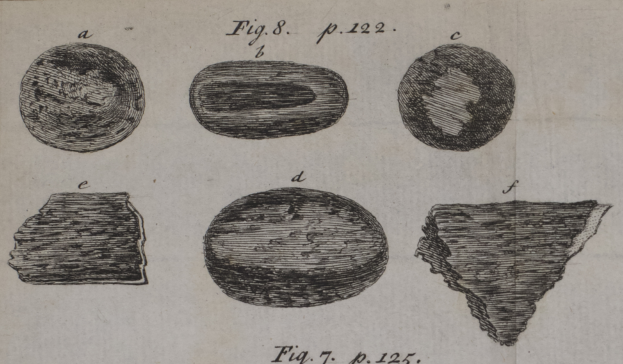VI. A Letter from Sir Hans Sloane Baronet, late Pr. R. S. to Martin Folkes Esquire Pr. R. S. containing Acconnts of the pretended Serpent-ſtone called Pietra de Cobra de Cabelos, and of the Pietra de Mombazza or the Rhinoceros Bezoar, together with the Figure of a Rhinoceros with a double Horn.
Chelſea, April 19, 1749.
Read April 20. 1749.
SIR,
I here ſend you to be communicated to the Society, if you think proper, an Account of two pretended Stones, ſaid to be found in the Head of the moſt venomous Snake of the Eaſt Indies called Cobra de Cabelo, together with an Account of what I have heard, and what I believe they really are.
(…)
I am,
SIR,
Your humble Servant,
Hans Sloane.
(…)
Pietre del Serpente Cobra de Cabelo * Redi Eſperienze, Nat. p. 3. Tab. i. Lapides Serpentis Cobras de Cabelo dicti, Edit. Latin. Pedra de Cobra, Kempfer. Amœnitat. Exot. p. 396. Pierres de Serpent. Biron Curioſit. de la Natura, &c. p. 72
Dr. John Bateman, my worthy Predeceſſor, formerly Preſident of the College of Phyſicians of London, told me, with great Admiration, that he had ſeen the great Effects (upon the Bite of a Viper) of the Snake-ſtone or Serpent-ſtone, as it is call’d, before King Charles II. who was a great Lover of ſuch Natural Experiments ; and that he knew the Perſon poſſeſſed of the very Stone he had ſeen tried, who he believed would part with it for Money.
Upon my Deſire and Requeſt to ſee him, he came to me, and brought with him the Stone, which was round and flat, as the common ones brought by Merchants and others from the Eaſt Indies, about the Size of a mill’d Shilling, but thickern for which he aſked five Guineas, tho’ it was broken. There are ſeveral of this Sort, figur’d in Tab. II. Fig. 8. a, b, c, d.
Dr. Alex. Stuart, who had been my Acquaintance for ſeveral Years, returning from the Eaſt Indies, brought from thence, among many other Curioſities, ſome of theſe Snake or Serpent-ſtones, together with this Account of them, which he had from a other Miſſionary in the Eaſt Indies, ‘that they were not taken out of a Serpent’s Head, but made of the Bones of the ſmall Buffalo in the Indies’ (by which their Coaches are drawn are drawn inſtead of Horſes) ; the Bones being half-calcin’d or char by the Dung of the ſame Buffalo. He gave me ſeveral Pieces, with ſome of the Snake or Serpent-ſtones made out of them, and which I have in my Collection of ſeveral Shape and Colours.
I think the firſt who gives any Account of them is Franceſco Redi at Florence, who had them from the Duke of Tuſcany‘s Collections, and who, in his Eſperienze Nat. tells great Virtues of them, related by three Franciſcan Friers, who came from the Eaſt Indies in 1662. which were, that, being applied to the Bites of the Viper, Aſp, or any other venomous Animals it ſticks very faſt till it has imbibed or attracted all the Poiſon (as a Loadſtone does Iron), as many People in the Indies believe, and then it falls off of itſelf ; and being put into new Milk, it parts with the Poiſon, and gives the Milk a bluiſh Colour ; of which Redi tells the Succeſs of thoſe he figured.
Kempfer, in his Amœnitat. Exot. p. 396 ſpeaking of this, ſays, it helps thoſe bit by Vipers, outwardly applied ; and that it is not fond in the Serpent’s Head, as believed, but by a ſecret Art made by the Brahmens ; and that, for the right and happy Application of it, there muſt be two ready ; that when one has fallen off fill’d with the Poiſon, the other may ſupply its Place. They are commonly, as he ſays, kept in a Box with Cotton, to be ready when Occaſion offers.
Biron ſays, that if the Wound of the Serpent has not bled, it muſt be a little prick’d, ſo as the Blood comes out, and then to be applied as uſual. It comes from the Kingdom of Camboya.
* Which ſignifies in Portugueſe, the hooded Serpent, becauſe it has a Membrane about its Head which it an expand like an Hood : By others it is called the Spectacle-Snake ; for on the back Part of its Neck is the Repreſentation of a pair of Spectacles. See a figure of one in Kempfer‘s Amœnit. Exotic. p. 567.
(…)
Tab. II
(…)
Fig. 8. a, b, c, d, repreſent the Pietre de Serpente Cobra de Cabelo, of an Aſh-colour and black. In that mark’d b, the dark Shade in the middle ſhews an Hollow, which was Part of the Cavity of the Inſide of the Bone. e and f are rough Pieces of Bones, half-calcin’d, porous, and not poliſh’d. The Figure and Deſcription of the Buffalo, whoſe Bones they uſe for this Purpoſe, are given in Mr. Edwards‘s Hiſtory of Birds, to which he has ſubjoined the Figures and Deſcriptions of ſome few rare Quadrupeds.
(…)

SLOANE, Hans. « A Letter from Sir Hans Sloane Baronet, late Pr. R. S. to Martin Folkes Esquire Pr. R. S. containing Acconnts of the pretended Serpent-stone called Pietra de Cobra de Cabelos, and of the Pietra de Mombazza or the Rhinoceros Bezoar, together with the Figure of a Rhinoceros with a double Horn. » Philosophical Transactions of the Royal Society. Vol. 46, Iss. 492 (avril, mai, juin 1749), London, 1750.
Voir le document original numérisé sur les sites suivants :
Police d’écriture utilisée pour la reproduction du texte ancien : IM FELL DW Pica. The Fell Types are digitally reproduced by Igino Marini. www.iginomarini.com
